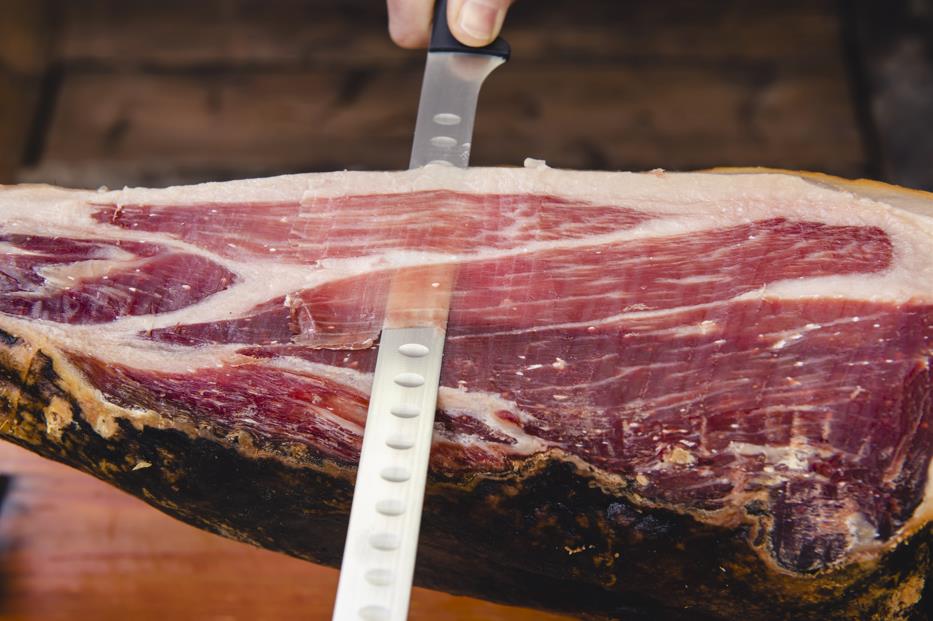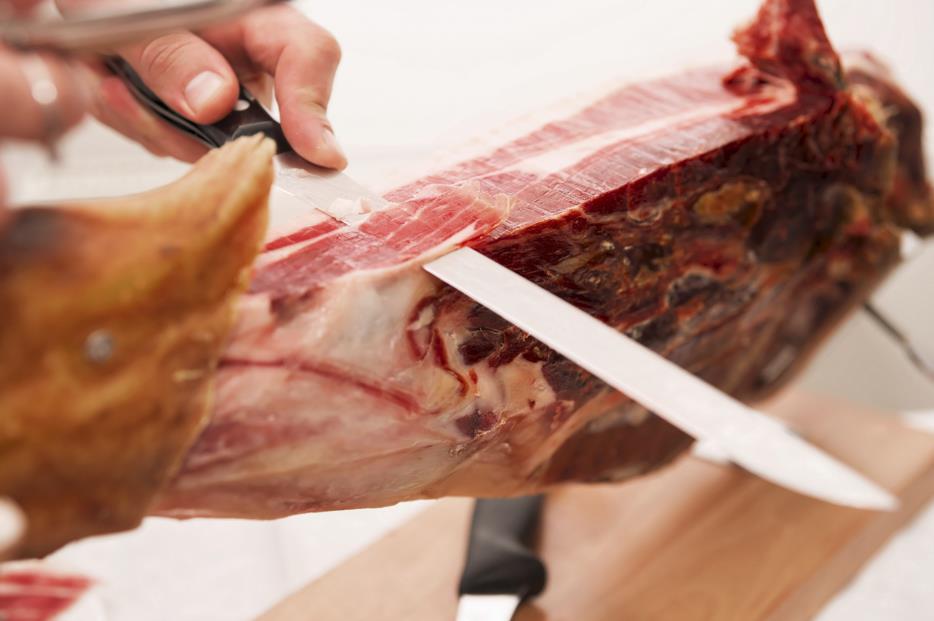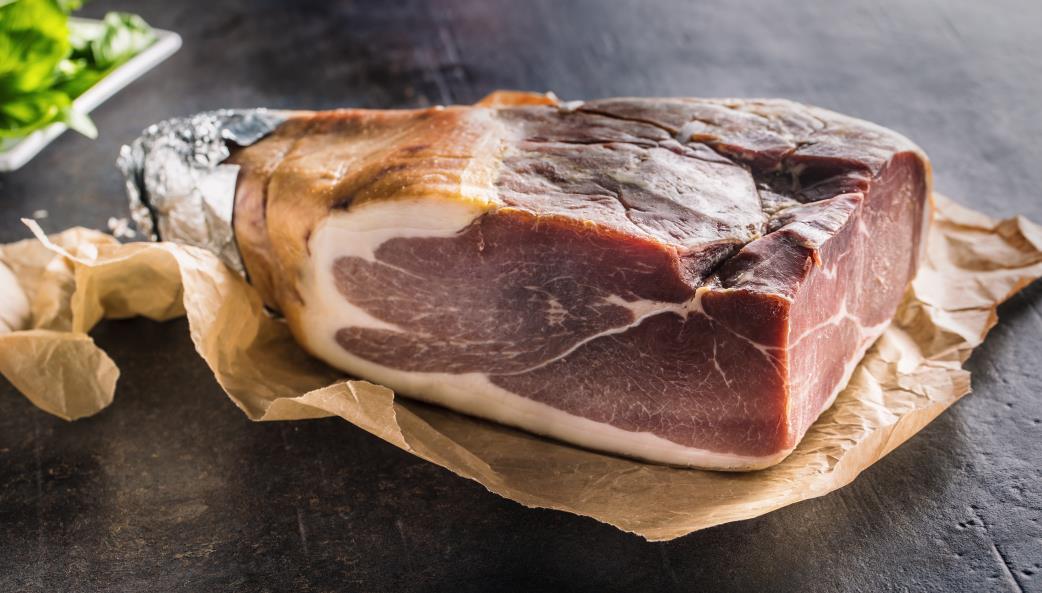A ham knife is a long, thin bladed kitchen knife used for slicing mainly hot or cold meats. Ham knives can look very much like a boning or filleting knife. They’re all part of the same knife ‘family’.
With a length of 8 to 12 inches in a flexible blade and either a rounded or pointed blade tip, this meat carving marvel does great duty in the kitchen.
Without further ado, join us in exploring this must-have tool for Sunday lunches, sushi, charcuterie and more!
Table of contents
The materials that go into a ham knife
Your ham knife, like other members of the knife family, can be made from a range of materials depending on local tastes and availability.
The most common material for ham knife blades would be a type of steel – either stainless steel, carbon steel, Damascus steel, ceramic steel, or an alloy like Polybdenum Titanium.
Ham knife handles can also be made from a wide range of materials, once again dependent on what’s in fashion or locally available.
Smooth or pitted blade?

With a wealth of choice and many knife ranges available today, consumers can choose between a ham knife that is either smooth bladed (without any scalloping or indentations on the blade) or one that is serrated, scalloped, or pitted.
All those terms mean the same thing, the knife blade will have pits or indentations along the side of the blade or along the blade edge itself to help the knife not to stick to the carved food.
Granton vs. smooth bladed ham knives
The term Granton in knife terminology has come to mean a knife blade that is dimpled or scalloped identically on both sides of the blade but has a straight blade edge.
A serrated blade differs in that the indentations will be along the blade edge only, not the sides of the blade itself as with a Granton blade.
A smooth bladed ham knife will be without any serration or indentations on the blade or blade edge at all.
So really, the different terms Granton, serrated or smooth are just ways to describe different texturing (or lack thereof) on a knife blade and knife blade edge.
A Granton edged blade can be sharpened as per normal, with a knife steel, pull through sharpening tool or a whetstone. Check your retailer’s or manufacturer’s directions on any knife product you buy before sharpening!
Benefits of a Granton edge on a ham knife
- Less sticking to whatever you’re cutting
- Great for soft or stickier foods like raw fish or cheeses
- Less tearing and shredding of delicate fibers
- It’s easier and quicker to carve a ham with something textured like a serrated ham knife because the slices fall apart easily for serving
Choosing a good quality ham knife
If you’re big into cheese boards or enjoying a fabulous Sunday lunch roast as often as you can, you’re going to need a star ham knife to get you carving and serving like a pro. Here are our top tips for choosing a good ham knife:
- Budget: Assess your budget, how often you will use your ham knife, and buy the best that your wallet can afford. Don’t neglect to do some homework first, there are loads of ham knives available today and they are not all created equal!
- Warranty: Look for a knife retailer or maker who offers a firm and clear warranty on their ham knife. A long-term warranty means that the company or maker has confidence in their product and the materials used to make it, this is what you’re looking for.
- Balance: Both the knife blade and the knife handle should be well balanced – this ensures that the ham knife will sit well in your hand and be a pleasure to use. If in store, pick up and handle the different ham knives, you’ll quickly note the differences in how different ham knives sit in your hand.
- Non–Slip Handle: Because you’re going to be using the ham knife on both delicate meats and perhaps larger joints, you need a solid, well balanced, and non-slip knife handle both for ease of use and to prevent accidents.
Recommended knife essentials
True cutting power in the palm of your hand
How to carve hams

Tools you’ll need:
- A chopping board large enough to rest the whole ham on
- A pronged fork utensil for holding the ham in place securely
- Your ham knife
- Boning knife (optional but handy)
- A plate or tray on which to place your carved slices ready for serving
Pro – tips: Secure your chopping board by resting it on a damp dish towel if it’s prone to sliding around. Make sure the knives are well sharpened.
How to carve a whole, bone in ham
- Place the ham on your cutting surface so that the lower leg, or shank, is to your right if you’re right-handed. If you’re left-handed, start with the shank on your left.
- Secure the ham firmly with the fork, then slice a couple of thin slices straight down (allowing some curvature of the joint) from the THIN side of the leg.
- Slice in this way until you have made a flattish base to the meat, this will help you turn the ham to steady it as you progress in slices.
- At this point the bone of the ham should be horizontal to the cutting surface, allowing you to cut perpendicular to the leg bone, cutting across the grain or muscle fibers of the meat.
- Continue slicing until you have removed the desired quantity of ham from the bone. A boning knife will come in handy at the end stages for removing any remaining bits of meat off the ham bone.
Remember to keep the ham bone – it’s wonderful in stocks and soups or for adding flavor to sauces. A ham bone will store well in the freezer for 2 years but using it within 3 to 6 months will ensure you get the most flavor out of it.
How to carve a ham shank or ham hock

This joint of meat is also known as a pork knuckle.
- Place the ham shank on its side on the chopping board so that its bone is horizontal to the board/cutting surface.
- Fix the ham shank firmly to the board with the meat fork and insert your ham knife just above the top of the bone.
- Using a gentle sawing motion, cut right through from the open end (where the bone begins) all the way to the end of the ham shank. This will divide the shank into 2 portions. Continue until both halves of meat are entirely off the bone.
- Placing the cut side of the meat down, you’re next going to slice each half of the shank into uniform slices, as thick or thin as you prefer. Once both sides of the shank are neatly sliced, you can use the boning knife or a pair of kitchen scissors to scrape off any remaining pieces of meat on the bone. Again, save that bone for further usage!
Your ham knife is not just limited to carving a ham or joints of meat either! Another fabulous way to use your ham knife is for charcuterie. As pictured above, a charcuterie is an arrangement of cured meats, fruit, preserves, and cheeses artistically displayed for maximum al fresco eating enjoyment.
Ham knife FAQs
Where else could I use my ham knife?
Ham knives are proficient at cutting through raw fish too, because they are flexible enough to sail through delicate fish without damaging the softer fibers. Consider using your ham knife as an additional tool the next time you have a sushi feast!
Should I trim a ham of fat before serving?
No. The fat on the ham will keep the surface and texture of your ham moist and delicious. By trimming it you expose the meat to the air, meaning that it dries out more quickly. If you have health issues that make fat unhealthy for you, trim the fat off your portion only after you’ve sliced it from the ham.
What’s the best way to hold a ham knife?
Hold your ham knife with all your fingers wrapped around the handle, no fingers on the blade! Your four fingers wrap around the middle of the handle, and your thumb on the other side close to the beginning of the blade to stabilize your ham knife for easy carving.
In conclusion
We’ve taken a good look at the handy and multi-purpose ham knife in this article and given you some excellent carving know-how to impress your guests. Do search other areas of our website for great information on other knives and how best you can use them at home or in the pro kitchen. Equip yourself with a quality handmade knife and experience an effortless cutting journey today!












